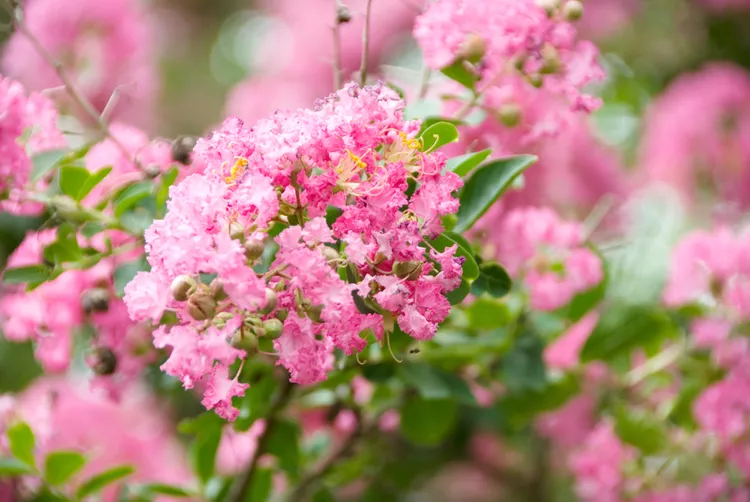Perhaps no shrub or tree suffers from the pruning mistreatment that crape myrtles do. You’ve seen the victims: majestic crape myrtles hacked down to hideous 3-foot high stumps by misguided homeowners and landscaping crews. It’s such a widespread problem that there’s a name for pruning these trees incorrectly: crape murder.
So when, why, and how should you prune your crape myrtle? This guide explains everything you need to know, and provides tips from an expert.
Ralph Mitchell is Director of the University of Florida’s Extension Office in Charlotte County, Florida.
Tips for Pruning Crape Myrtle
Crape myrtle trees actually need very little pruning. So why is crape murder so widespread?
“People just don’t understand how to prune crape myrtles,” says Ralph Mitchell, Director of the University of Florida’s Extension Office in Charlotte County, Florida. “They usually cut way too much off them and harm the plant. Less is more is my mantra when it comes to pruning crape myrtles.”
Your objectives when pruning a crape myrtle are to maintain its natural form, encourage it to grow strong branches, and open up its center to show off the smooth, multi-hued bark that grows on mature trunks. And let these tips guide your pruning shears as you work toward these goals.
1. Prune crape myrtle in winter.
The best time for pruning crape myrtle is late winter because it’s easy to see all the branches before it has sprouted leaves. Crape myrtles bloom on new growth, so there’s no danger of ruining spring flowers. Late winter pruning may spur more blooms by encouraging the plant to put its energy into its flowers instead of its branches.
2. Do not lop off the top.
Do not behead your crape myrtle. “That’s what we call crape murder,” Mitchell says. Top the crape myrtle and you’ll make the hapless plant look like a shapeless bundle of ugly stumps, stunt its growth, and keep it from growing the lovely, papery bark that develops on mature trees and provides winter interest. “Topping a crape myrtle can lead to disease and decay and taking that much wood off the tree can stress it,” Mitchell says. “Don’t do it, topping is terrible.”
3. Prune lightly.
Prune off any dead or dying branches or branches that have crossed one another. “Remove branches that are crowded so air and sunlight can get to the middle of the crape myrtle,” Mitchell says. The goal is to maintain healthy, well-spaced trunks that make up the main architecture of the tree. “Never remove more than 25 percent of the tree in one pruning,” Mitchell says. Over-pruning can delay flowering, stress the tree, and lead to diseased wood in the stems and trunk because you remove the plant’s stored food reserves.
4. Limit the number of trunks to 3 to 5.
Crape myrtles are naturally multi-trunked trees with an umbrella-like form, but aim to limit the number of main trunks to three to five. Don’t let it grow more than seven. Fewer trunks tame the crape myrtle’s spread and give it a lovely form.
Some people trim crape myrtle trees to a single trunk, but you will need to do this when it’s a young plant and choose a variety with a more upright habit, like Natchez, Twilight Magic, and Tuscarora. Single-trunk crape myrtles can fit into a tighter spaces.
5. Cut off the suckers.
Remove suckers from the base of the tree. This is the new growth that emerges from the roots, and you should snip them off. “You don’t want those to become a mass of new wood,” Mitchell says. They take energy from the main plant and if left to mature into branches will turn the crape myrtle into a sprawling, misshapen mess.
6. Don't remove seed pods.
You can cut off old seed pods but it’s not necessary, Mitchell says. Some people think the crape myrtle won’t bloom next year if the seed pods are left on the tree, but that is not true. The crape myrtle will bloom fine.
While it’s okay to leave seed pods on crape myrtle trees, if you remove them in early summer, right after the crape myrtles bloom, you may get a second bloom in the fall.
Restoring a Butchered Crape Myrtle
Let's say you have a crape myrtle that has been crape murdered and is now a bunch of trunks standing a few feet off the ground. Here’s how to remedy the situation and continue pruning crape myrtle trees correctly:
- Cut the trunks completely to the ground. It will grow back fast, and be covered in sprouts.
- Leave it alone for a year.
- The next winter, choose three to five well-spaced, healthy stems (future trunks) and cut off all the others at ground level.
- Keep pruning, following the tips above, and you’ll have a healthy crape myrtle in five years or so.




















